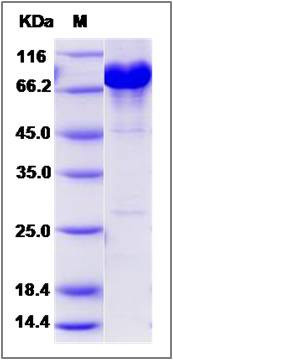Human NCF-2 / NCF2 / P67phox Protein (His & GST Tag)
NCF-2,NOXA2,P67-PHOX,P67PHOX
- 100ug (NPP2360) Please inquiry
| Catalog Number | P15669-H20B |
|---|---|
| Organism Species | Human |
| Host | Baculovirus-Insect Cells |
| Synonyms | NCF-2,NOXA2,P67-PHOX,P67PHOX |
| Molecular Weight | The recombinant human NCF2 /GST chimera consists of 763 amino acids and has a calculated molecular mass of 87.6 kDa. The recombinant protein migrates as an approximately 80-90 kDa band in SDS-PAGE under reducing conditions. |
| predicted N | Met |
| SDS-PAGE |  |
| Purity | > 90 % as determined by SDS-PAGE |
| Protein Construction | A DNA sequence encoding the human NCF2 (AAH01606.1) (Met1-Val526) was fused with the N-terminal polyhistidine-tagged GST tag at the N-terminus. |
| Bio-activity | |
| Research Area | Developmental Biology |Metabolism |Types of disease |Metabolism in Cancer |
| Formulation | Lyophilized from sterile 20mM Tris, 500mM Nacl, 10% glycerol, pH 7.4. 1. Normally 5 % - 8 % trehalose, mannitol and 0.01% Tween80 are added as protectants before lyophilization. Specific concentrations are included in the hardcopy of COA. |
| Background | NCF2, also known as NCF-2 and p67phox, is a subunit of the multi-protein NADPH oxidase complex. NCF2, NCF1, and a membrane bound cytochrome b558 are required for activation of the latent NADPH oxidase. This oxidase produces a burst of superoxide which is delivered to the lumen of the neutrophil phagosome. Mutations in NCF2 gene, as well as in other NADPH oxidase subunits, can result in chronic granulomatous disease, a disease that causes recurrent infections by catalase-positive organisms. |
| Reference |
